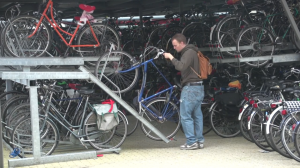Of all the videos you’ve seen of the Netherlands, this one is the least likely to make you dig into your IRA and call KLM.
It shows a group of municipal bureaucrats from America touring the Netherlands to learn how that country has promoted bicycling. So, no windmills. Not much focus on the architecture of charming old Amsterdam. Only a very few panoramas of boats chugging along picturesque canals. Certainly no titillating references to “coffee” shops and no racy after-dark shots of the Rosse Buurt.
Lots of bike racks, though. Lots and lots of bike racks.
Still, the video is worth a look. It’s an informative introduction to one country’s very conscious—and very successful—effort to get citizens out of their cars and onto a path. Today (we are told) 27 percent of all trips in the Netherlands are made on a bike. And in central Amsterdam, the number is closer to 50 percent.
Granted, it’s easier to convince people to bike when many of the narrow streets make driving slow and nightmarish. Also, trips are more feasible in a region where likely destinations aren’t as spread out as they are in, say, Nevada. But there are cities in the United States where biking would work, and cut congestion, and reduce emissions. And it might help this nagging obesity thing we have going.
Back to the racks, which are impressive. How so? First, they appear to be plentiful and large–one featured here holds 2,000 bikes. (And it’s guarded. And free.) If you’ve ever wandered the street looking for an open signpost because the bike rack you’d planned to use was absolutely filled, this matters to you. Next, even though some of them have two levels, they’re easily negotiated. In some of them, each slot knows when it’s being used; the information is displayed on signs so cyclists can pull up and instantly determine if there’s a spot for their bike and roughly where it is.
The concentration of two-wheeled, human-powered vehicles–rows upon rows of them in these racks–demonstrates how successful the bike promotion has been. And what the country’s leaders have done for their citizens. It’s easy to translate how the roads would look…and how the air would feel in your lungs…if all those bikes were converted to cars, as they are in most U.S. cities.
As the video’s narrator points out, there isn’t something in the Dutch DNA that predisposes them to biking. They just made a decision, put some money into the infrastructure, and encouraged people to get moving. It can be done.
From the Netherlands to America: Translating the World’s Best Bikeway Designs from Streetfilms on Vimeo.










